Continued fraction
In mathematics, a continued fraction is an expression such as
where a0 is some integer and all the other numbers ai (i ≠ 0) are positive integers. Longer expressions are defined analogously. If the partial numerators and partial denominators are allowed to assume arbitrary values, which may in some contexts include functions, the resulting expression is a generalized continued fraction. When it is necessary to distinguish the standard form above from generalized continued fractions, it may be called a simple or regular continued fraction, or is said to be in canonical form.
Motivation
The study of continued fractions is motivated by a desire to have a "mathematically pure" representation for the real numbers.
Most people are familiar with the decimal representation of real numbers, which may be defined by
where a0 may be any integer, and every other ai is an element of {0, 1, 2, ..., 9}. In this representation, the number π, for example, is represented by the sequence of integers (ai) = (3, 1, 4, 1, 5, 9, 2, ...).
This decimal representation has some problems. For example, the constant 10 is used in this case because we are computing here in the base 10 numeral system. We might wish to use base 8 (octal) or base 2 (binary). Another problem is that many rational numbers lack finite representations in this system. For example, the number 1/3 is represented by the infinite sequence (0, 3, 3, 3, 3, ....).
Continued fraction notation is a representation of the real numbers that avoids both these problems. Let us consider how we might describe a number like 415/93, which is around 4.4624. This is approximately 4. Actually it is a little bit more than 4, about 4 + 1/2. But the 2 in the denominator is not correct; the correct denominator is a little bit more than 2, about 2 + 1/6, so 415/93 is approximately 4 + 1/(2 + 1/6). But the 6 in the denominator is not correct; the correct denominator is a little bit more than 6, actually 6+1/7. So 415/93 is actually 4+1/(2+1/(6+1/7)). This is exact.
Dropping the redundant parts of the expression 4 + 1/(2 + 1/(6 + 1/7)) gives the abbreviated notation [4; 2, 6, 7].
The continued fraction representation of real numbers can be defined in this way. It has several desirable properties:
- The continued fraction representation for a number is finite if and only if the number is rational.
- Continued fraction representations for "simple" rational numbers are usually short.
- The continued fraction representation of any rational number is unique if it has no trailing 1. (However, [a0; a1, ... an, 1] = [a0; a1, ... an + 1].)
- The continued fraction representation of an irrational number is unique.
- The terms of a continued fraction will repeat if and only if it is the continued fraction representation of a quadratic irrational, that is, a real solution to a quadratic equation with integer coefficients.[1] For example, the repeating continued fraction [1; 1, 1, 1, ...] is the golden ratio, and the repeating continued fraction [1; 2, 2, 2, ...] is the square root of 2.
- Truncating the continued fraction representation of a number x early yields a rational approximation for x which is in a certain sense the "best possible" rational approximation (see theorem 5, corollary 1 below for a formal statement).
This last property is extremely important, and is not true of the conventional decimal representation. Truncating the decimal representation of a number yields a rational approximation of that number, but not usually a very good approximation. For example, truncating 1/7 = 0.142857... at various places yields approximations such as 142/1000, 14/100, and 1/10. But clearly the best rational approximation is "1/7" itself. Truncating the decimal representation of π yields approximations such as 31415/10000 and 314/100. The continued fraction representation of π begins [3; 7, 15, 1, 292, ...]. Truncating this representation yields the excellent rational approximations 3, 22/7, 333/106, 355/113, 103993/33102, ... The denominators of 314/100 and 333/106 are almost the same, but the error in the approximation 314/100 is nineteen times as large as the error in 333/106. As an approximation to π, [3; 7, 15, 1] is more than one hundred times more accurate than 3.1416.
Calculating continued fraction representations
Consider a real number r. Let i be the integer part and f the fractional part of r. Then the continued fraction representation of r is [i; …], where "…" is the continued fraction representation of 1/f. It is customary to replace the first comma by a semicolon.
To calculate a continued fraction representation of a number r, write down the integer part (technically the floor) of r. Subtract this integer part from r. If the difference is 0, stop; otherwise find the reciprocal of the difference and repeat. The procedure will halt if and only if r was rational.
| Find the continued fraction for 3.245 (3 49/200) | ||||
|---|---|---|---|---|
 |
 |
 |
 |
 |
 |
 |
 |
 |
 |
 |
 |
 |
 |
 |
 |
 |
 |
STOP | |
| continued fraction form for 3.245 (3 49/200) is [3; 4, 12, 4] | ||||
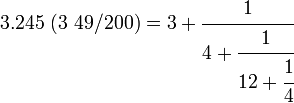 |
||||
The number 3.245 (3 49/200) can also be represented by the continued fraction expansion [3; 4, 12, 3, 1]; refer to Finite continued fractions below.
This algorithm is suitable for real numbers, but the limited precision of floating point numbers will often lead to small errors, skewing the final result. Instead, floating point numbers should be converted to rational numbers. The denominator is usually a power of two on modern computers, and a power of ten on electronic calculators, so a variant of Euclid's GCD algorithm can be used to give exact results.
Notations for continued fractions
The integers a0, a1, etc., are called the quotients of the continued fraction. One can abbreviate a continued fraction as
or, in the notation of Pringsheim, as
Here is another related notation:
Sometimes angle brackets are used, like this:
The semicolon in the square and angle bracket notations is sometimes replaced by a comma.
One may also define infinite simple continued fractions as limits:
This limit exists for any choice of positive integers a0, a1, ... .
Finite continued fractions
Every finite continued fraction represents a rational number, and every rational number can be represented in precisely two different ways as a finite continued fraction. These two representations agree except in their final terms. In the longer representation the final term in the continued fraction is 1; the shorter representation drops the final 1, but increases the new final term by 1. The final element in the short representation is therefore greater than 1, if the short representation has at least two terms. In symbols:
For example,
Continued fractions of reciprocals
The continued fraction representations of a positive rational number and its reciprocal are identical except for a shift one place left or right depending on whether the number is less than or greater than one respectively. In other words, the numbers represented by ![[a_0;a_1,a_2,a_3,\ldots,a_n]](/2009-wikipedia_en_wp1-0.7_2009-05/I/371951e599137b2a4dc77b15f08da9f7.png) and
and ![[0;a_0,a_1,a_2,\ldots,a_n]](/2009-wikipedia_en_wp1-0.7_2009-05/I/ec441968137bb5480ee35884c3ceea36.png) are reciprocals. This is because if
are reciprocals. This is because if  is an integer then if
is an integer then if  then
then  and
and  and if
and if  then
then  and
and  with the last number that generates the remainder of the continued fraction being the same for both
with the last number that generates the remainder of the continued fraction being the same for both  and its reciprocal.
and its reciprocal.
For example,
Infinite continued fractions
Every infinite continued fraction is irrational, and every irrational number can be represented in precisely one way as an infinite continued fraction.
An infinite continued fraction representation for an irrational number is mainly useful because its initial segments provide excellent rational approximations to the number. These rational numbers are called the convergents of the continued fraction. Even-numbered convergents are smaller than the original number, while odd-numbered ones are bigger.
For a continued fraction [a0; a1, a2, ...], the first four convergents (numbered 0 through 3) are
In words, the numerator of the third convergent is formed by multiplying the numerator of the second convergent by the third quotient, and adding the numerator of the first convergent. The denominators are formed similarly.
If successive convergents are found, with numerators h1, h2, ... and denominators k1, k2, ... then the relevant recursive relation is:

The successive convergents are given by the formula
Some useful theorems
If a0, a1, a2, ... is an infinite sequence of positive integers, define the sequences  and
and  recursively:
recursively:
 |
 |
 |
|||
 |
 |
 |
Theorem 1
For any positive 
Theorem 2
The convergents of [a0; a1, a2, ...] are given by
Theorem 3
If the nth convergent to a continued fraction is  , then
, then
Corollary 1: Each convergent is in its lowest terms (for if  and
and  had a nontrivial common divisor it would divide
had a nontrivial common divisor it would divide  , which is impossible).
, which is impossible).
Corollary 2: The difference between successive convergents is a fraction whose numerator is unity:
Corollary 3: The continued fraction is equivalent to a series of alternating terms:
Corollary 4: The matrix
has determinant plus or minus one, and thus belongs to the group of 2x2 unimodular matrices  .
.
Theorem 4
Each (sth) convergent is nearer to a subsequent (nth) convergent than any preceding (rth) convergent is. In symbols, if the nth convergent is taken to be ![[a_0;a_1,a_2,\ldots a_n]=x_n](/2009-wikipedia_en_wp1-0.7_2009-05/I/ae1e4ae3bd78e70fbdfdcd86423f72d8.png) , then
, then
for all r < s < n.
Corollary 1: the even convergents (before the nth) continually increase, but are always less than xn.
Corollary 2: the odd convergents (before the nth) continually decrease, but are always greater than xn.
Theorem 5
Corollary 1: any convergent is nearer to the continued fraction than any other fraction whose denominator is less than that of the convergent
Corollary 2: any convergent which immediately precedes a large quotient is a near approximation to the continued fraction.
Semiconvergents
If
 and
and 
are successive convergents, then any fraction of the form
where a is a nonnegative integer and the numerators and denominators are between the n and n + 1 terms inclusive are called semiconvergents, secondary convergents, or intermediate fractions. Often the term is taken to mean that being a semiconvergent excludes the possibility of being a convergent, rather than that a convergent is a kind of semiconvergent.
The semiconvergents to the continued fraction expansion of a real number x include all the rational approximations which are better than any approximation with a smaller denominator. Another useful property is that consecutive semiconvergents a/b and c/d are such that ad − bc = ±1.
Best rational approximations
A best rational approximation to a real number x is a rational number n⁄d, d > 0, that is closer to x than any approximation with a smaller denominator. The simple continued fraction for x generates all of the best rational approximations for x according to three rules:
- Truncate the continued fraction, and possibly decrement its last term.
- The decremented term cannot have less than half its original value.
- If the final term is even, a special rule decides if half its value is admissible. (See below.)
For example, 0.84375 has continued fraction [0;1,5,2,2]. Here are all of its best rational approximations.
-
[0;1] [0;1,3] [0;1,4] [0;1,5] [0;1,5,2] [0;1,5,2,1] [0;1,5,2,2] 1 3⁄4 4⁄5 5⁄6 11⁄13 16⁄19 27⁄32
The strictly monotonic increase in the denominators as additional terms are included permits an algorithm to impose a limit, either on size of denominator or closeness of approximation.
To incorporate a new term into a rational approximation, only the two previous convergents are necessary. If ak+1 is the new term, then the new numerator and denominator are
The initial "convergents" (required for the first two terms) are 0⁄1 and 1⁄0. For example, here are the convergents for [0;1,5,2,2].
-
k −2 −1 0 1 2 3 4 ak 0 1 5 2 2 nk 0 1 0 1 5 11 27 dk 1 0 1 1 6 13 32
One formal description of the half rule is that the halved term, 1⁄2 ak, is admissible if and only if
The convergents to x are best approximations in an even stronger sense: n⁄d is a convergent for x if and only if |dx − n| is the least relative error among all approximations m⁄c with c ≤ d; that is, we have |dx − n| < |cx − m| so long as c < d. (Note also that |dkx − nk| → 0 as k → ∞.)
Comparison of continued fractions
Consider x = [a0, a1, ...] and y = [b0, b1, ...]. If k is the smallest index for which ak is unequal to bk then x < y if (−1)k(ak − bk) < 0 and y < x otherwise.
If there is no such k, but one expansion is shorter than the other, say x = [a0, a1, ..., an] and y = [b0, b1, ..., bn, bn+1, ...] with ai = bi for 0 ≤ i ≤ n, then x < y if n is even and y < x if n is odd.
Continued fraction expansions of π
To calculate the convergents of pi we may set  , define
, define 
 and
and  ,
,  and
and  ,
, 
 . Continuing like this, one can determine the infinite continued fraction of π as [3; 7, 15, 1, 292, 1, 1, ...]. The third convergent of π is [3; 7, 15, 1] = 355/113 = 3.14159292035..., which is fairly close to the true value of π.
. Continuing like this, one can determine the infinite continued fraction of π as [3; 7, 15, 1, 292, 1, 1, ...]. The third convergent of π is [3; 7, 15, 1] = 355/113 = 3.14159292035..., which is fairly close to the true value of π.
Let us suppose that the quotients found are, as above, [3; 7, 15, 1]. The following is a rule by which we can write down at once the convergent fractions which result from these quotients without developing the continued fraction.
The first quotient, supposed divided by unity, will give the first fraction, which will be too small, namely, 3/1. Then, multiplying the numerator and denominator of this fraction by the second quotient and adding unity to the numerator, we shall have the second fraction, 22/7, which will be too large. Multiplying in like manner the numerator and denominator of this fraction by the third quotient, and adding to the numerator the numerator of the preceding fraction, and to the denominator the denominator of the preceding fraction, we shall have the third fraction, which will be too small. Thus, the third quotient being 15, we have for our numerator (22 × 15 = 330) + 3 = 333, and for our denominator, (7 × 15 = 105) + 1 = 106. The third convergent, therefore, is 333/106. We proceed in the same manner for the fourth convergent. The fourth quotient being 1, we say 333 times 1 is 333, and this plus 22, the numerator of the fraction preceding, is 355; similarly, 106 times 1 is 106, and this plus 7 is 113.
In this manner, by employing the four quotients [3; 7, 15, 1], we obtain the four fractions:
These convergents are alternately smaller and larger than the true value of π, and approach nearer and nearer to π. The difference between a given convergent and π is less than the reciprocal of the product of the denominators of that convergent and the next convergent. For example, the fraction 22/7 is greater than π, but 22/7 − π is less than 1/(7×106), that is 1/742 (in fact, 22/7 − π is just less than 1/790).
The demonstration of the foregoing properties is deduced from the fact that if we seek the difference between one of the convergent fractions and the next adjacent to it we shall obtain a fraction of which the numerator is always unity and the denominator the product of the two denominators. Thus the difference between 22/7 and 3/1 is 1/7, in excess; between 333/106 and 22/7, 1/742, in deficit; between 355/113 and 333/106, 1/11978, in excess; and so on. The result being, that by employing this series of differences we can express in another and very simple manner the fractions with which we are here concerned, by means of a second series of fractions of which the numerators are all unity and the denominators successively be the product of every two adjacent denominators. Instead of the fractions written above, we have thus the series:
The first term, as we see, is the first fraction; the first and second together give the second fraction, 22/7; the first, the second and the third give the third fraction 333/106, and so on with the rest; the result being that the series entire is equivalent to the original value.
- For more see π.
The sequence of partial denominators of the simple continued fraction of π is somewhat unpredictable and irregular:
However, there are generalized continued fractions for π with a perfectly regular structure, such as:
where each of the numerators is an odd number squared.
Other continued fraction expansions
Periodic continued fractions
The numbers with periodic continued fraction expansion are precisely the irrational solutions of quadratic equations with rational coefficients (rational solutions have finite continued fraction expansions as previously stated). The simplest examples are the golden ratio φ = [1; 1, 1, 1, 1, 1, ...] and √ 2 = [1; 2, 2, 2, 2, ...]; while √14 = [3;1,2,1,6,1,2,1,6...] and √42 = [6;2,12,2,12,2,12...]. All irrational square roots of integers have a special form for the period; a symmetrical string, like the empty string (for √ 2) or 1,2,1 (for √14), followed by the double of the leading integer.
A property of the golden ratio φ
An interesting result, stemming from the fact that the continued fraction expansion for φ doesn't use any integers greater than 1, is that φ is one of the most "difficult" real numbers to approximate with rational numbers. One theorem[2] states that any real number k can be approximated by rational m/n with
While virtually all real numbers k will eventually have infinitely many convergents m/n whose distance from k is significantly smaller than this limit, the convergents for φ (i.e., the numbers 5/3, 8/5, 13/8, 21/13, etc.) consistently "toe the boundary", keeping a distance of almost exactly  away from φ, thus never producing an approximation nearly as impressive as, for example, 355/113 for π. It can also be shown that every real number of the form (a + bφ)/(c + dφ) – where a, b, c, and d are integers such that ad − bc = ±1 – shares this property with the golden ratio φ.
away from φ, thus never producing an approximation nearly as impressive as, for example, 355/113 for π. It can also be shown that every real number of the form (a + bφ)/(c + dφ) – where a, b, c, and d are integers such that ad − bc = ±1 – shares this property with the golden ratio φ.
Regular patterns in continued fractions
While one cannot discern any pattern in the simple continued fraction expansion of π, this is not true for e, the base of the natural logarithm:
We also have, when n is an integer greater than one,
Another, more complex pattern appears in this continued fraction expansion:
Other continued fractions of this sort are
where n is a positive integer; also
and, for integral n > 1,
If In(x) is the modified, or hyperbolic, Bessel function of the first kind, we may define a function on the rationals p/q by
which is defined for all rational numbers, with p and q in lowest terms. Then for all nonnegative rationals, we have
with similar formulas for negative rationals; in particular we have
The last two formulas are most easily proven in terms of the Bessel-Clifford function.
Typical continued fractions
Most irrational numbers do not have any periodic or regular behavior in their continued fraction expansion. Nevertheless Khinchin proved that for almost all real numbers x, the ai (for i = 1, 2, 3, ...) have an astonishing property: their geometric mean is a constant (known as Khinchin's constant, K ≈ 2.6854520010...) independent of the value of x. Paul Lévy showed that the nth root of the denominator of the nth convergent of the continued fraction expansion of almost all real numbers approaches an asymptotic limit, which is known as Lévy's constant. Lochs' theorem states that nth convergent of the continued fraction expansion of almost all real numbers determines the number to an average accuracy of just over n decimal places.
Pell's equation
Continued fractions play an essential role in the solution of Pell's equation. For example, for positive integers p and q, p2 − 2q2 = ±1 if and only if p/q is a convergent of √2.
Continued fractions and chaos
Continued fractions also play a role in the study of chaos, where they tie together the Farey fractions which are seen in the Mandelbrot set with Minkowski's question mark function and the modular group Gamma.
The backwards shift operator for continued fractions is the map  called the Gauss map, which lops off digits of a continued fraction expansion:
called the Gauss map, which lops off digits of a continued fraction expansion: ![h([0;a_1,a_2,a_3,\dots]) = [0;a_2,a_3,\dots]](/2009-wikipedia_en_wp1-0.7_2009-05/I/89681ecc87ecc413155afda307335c77.png) . The transfer operator of this map is called the Gauss-Kuzmin-Wirsing operator. The distribution of the digits in continued fractions is given by the zero'th eigenvector of this operator, and is called the Gauss-Kuzmin distribution.
. The transfer operator of this map is called the Gauss-Kuzmin-Wirsing operator. The distribution of the digits in continued fractions is given by the zero'th eigenvector of this operator, and is called the Gauss-Kuzmin distribution.
Eigenvalues and eigenvectors
The Lanczos algorithm uses a continued fraction expansion to iteratively approximate the eigenvalues and eigenvectors of a large sparse matrix.
History of continued fractions
- 300 BC Euclid, Elements - Algorithm for greatest common divisor which generates a continued fraction as a by-product
- 499 Aryabhatta - The Aryabhatiya contains the solution of indeterminate equations using continued fractions
- 1579 Rafael Bombelli, L'Algebra Opera - method for the extraction of square roots which is related to continued fractions
- 1613 Pietro Cataldi, Trattato del modo brevissimo di trovar la radice quadra delli numeri - first notation for continued fractions
- Cataldi represented a continued fraction as
 &
& &
& &
& with the dots indicating where the following fractions went.
with the dots indicating where the following fractions went.
- 1695 John Wallis, Opera Mathematica - introduction of the term "continued fraction"
- 1737 Leonhard Euler, De fractionibus continuis dissertatio - Provided the first then-comprehensive account of the properties of continued fractions, and included the first proof that the number e is irrational.[3]
- 1748 Euler, Introductio in analysin infinitorum. Vol. I, Chapter 18 - proved the equivalence of a certain form of continued fraction and a generalized infinite series, proved that every rational number can be written as a finite continued fraction, and proved that the continued fraction of an irrational number is infinite.[4]
- 1761 Johann Lambert - gave the first proof of the irrationality of π using a continued fraction for tan(x).
- 1768 Joseph Louis Lagrange - provided the general solution to Pell's equation using continued fractions similar to Bombelli's
- 1770 Lagrange - proved that quadratic irrationals have a periodic continued fraction expansion
- 1813 Karl Friedrich Gauss, Werke, Vol. 3, pp. 134-138 - derived a very general complex-valued continued fraction viā a clever identity involving the hypergeometric series
- 1972 Bill Gosper. - First exact algorithms for continued fraction arithmetic.
See also
- Complete quotient
- Engel expansion
- Mathematical constants (sorted by continued fraction representation)
- Restricted partial quotients
- Infinite series
- Infinite product
- Iterated binary operation
Notes
- ↑ Eric W. Weisstein, Periodic Continued Fraction at MathWorld.
- ↑ Theorem 193: Hardy, G.H.; Wright, E.M. (1979), An Introduction to the Theory of Numbers (Fifth ed.), Oxford
- ↑ Sandifer, Ed (February 2006). "How Euler Did It: Who proved e is irrational?" (PDF). MAA Online. http://www.maa.org/editorial/euler/How%20Euler%20Did%20It%2028%20e%20is%20irrational.pdf.
- ↑ "E101 -- Introductio in analysin infinitorum, volume 1". Retrieved on 2008-03-16.
References
- Jones, William B.; Thron, W. J. (1980), Continued Fractions: Analytic Theory and Applications. Encyclopedia of Mathematics and its Applications., 11, Addison-Wesley Publishing Company, ISBN 0-201-13510-8
- A. Ya. Khinchin, Continued Fractions, 1935, English translation University of Chicago Press, 1961 ISBN 0-486-69630-8
- Oskar Perron, Die Lehre von den Kettenbrüchen, Chelsea Publishing Company, New York, NY 1950.
- Andrew M. Rockett and Peter Szusz, Continued Fractions, World Scientific Press, 1992 ISBN 978-9-81-021052-6
- H. S. Wall, Analytic Theory of Continued Fractions, D. Van Nostrand Company, Inc., 1948 ISBN 0-8284-0207-8
- A. Cuyt, V. Brevik Petersen, B. Verdonk, H. Waadeland, W.B. Jones, Handbook of Continued fractions for Special functions, Springer Verlag, 2008 ISBN 978-1-4020-6948-2
External links
- Online Tool to Represent Continued Fractions: gives the abbreviated [...] notation as well as the conventional fractional notation.
- Linas Vepstas Continued Fractions and Gaps (2004) reviews chaotic structures in continued fractions.
- Continued Fractions on the Stern-Brocot Tree at cut-the-knot
- Francois Balsalobre cfc - a (cli) continued fraction calculator for POSIX and Cygwin
- The Antikythera Mechanism I: Gear ratios and continued fractions
- Continued Fraction Arithmetic Gosper's first continued fractions paper, unpublished. Cached on the Internet Archive's Wayback Machine
- Eric W. Weisstein, Continued Fraction at MathWorld.
- Continued Fractions by Stephen Wolfram and Continued Fraction Approximations of the Tangent Function by Michael Trott, Wolfram Demonstrations Project.
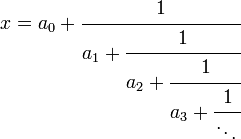

![x = [a_0; a_1, a_2, a_3] \;](/2009-wikipedia_en_wp1-0.7_2009-05/I/6382cc2d91f73d44f69895b6d2b3ea06.png)



![[a_0; a_1, a_2, a_3, \,\ldots ] = \lim_{n \to \infty} [a_0; a_1, a_2, \,\ldots, a_n].](/2009-wikipedia_en_wp1-0.7_2009-05/I/61e8d3912f012f1b1be348b7ffbf1c65.png)
![[a_{0}; a_{1}, a_{2}, a_{3}, \,\ldots ,a_{n}, 1]=[a_{0}; a_{1}, a_{2}, a_{3}, \,\ldots, a_{n} + 1]. \;](/2009-wikipedia_en_wp1-0.7_2009-05/I/5ab40f4a7d87e10b6f12496113d61dbd.png)
![2.25 = 9/4 = [2; 3, 1] = [2; 4], \;](/2009-wikipedia_en_wp1-0.7_2009-05/I/18b8dfd2869231a09bb54cdef873d53e.png)
![-4.2 = -21/5 = [-5; 1, 3, 1] = [-5; 1, 4]. \;](/2009-wikipedia_en_wp1-0.7_2009-05/I/4bd200fd7f59fedc8ae2cb420da3fe86.png)
![2.25 = \frac{9}{4} = [2; 4], \;](/2009-wikipedia_en_wp1-0.7_2009-05/I/3d8f2c12ea520aa1fa2375705fd9e2a6.png)
![\frac{1}{2.25} = \frac{4}{9} = [0; 2, 4]. \;](/2009-wikipedia_en_wp1-0.7_2009-05/I/e31b7959b8e322c1758a9830f36656b3.png)


![\left[a_0; a_1, \,\dots, a_{n-1}, x \right]=
\frac{x h_{n-1}+h_{n-2}}
{x k_{n-1}+k_{n-2}}.](/2009-wikipedia_en_wp1-0.7_2009-05/I/2121d15f37eb60c326eb9df0b64ff328.png)
![\left[a_0; a_1, \,\dots, a_n\right]=
\frac{h_n}
{k_n}.](/2009-wikipedia_en_wp1-0.7_2009-05/I/15b0b6545256be89c8c732a82ea531d7.png)









![\left[a_k;a_{k-1},\ldots,a_1\right] > \left[a_k;a_{k+1},\ldots\right].](/2009-wikipedia_en_wp1-0.7_2009-05/I/60a0c4401e4ab0fff61df7d03d176968.png)


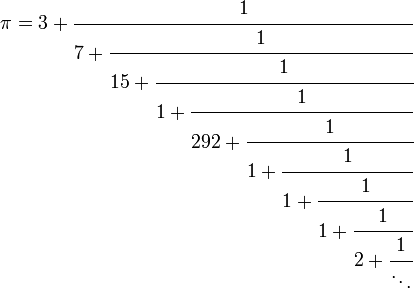
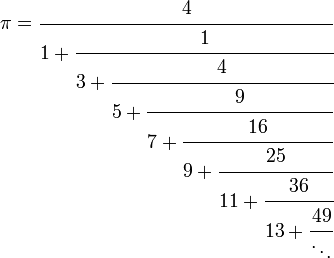
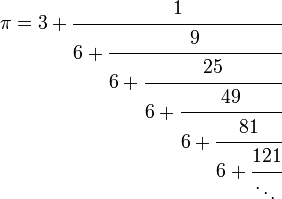

![e = \exp(1) = [2; 1, 2, 1, 1, 4, 1, 1, 6, 1, 1, 8, 1, 1, 10, 1, 1, 12, \dots] \,\!](/2009-wikipedia_en_wp1-0.7_2009-05/I/58714cd99ce5bc885516220e280b323c.png)
![\exp(1/n) = [1; n-1, 1, 1, 3n-1, 1, 1, 5n-1, 1, 1, 7n-1, \dots] \,\!](/2009-wikipedia_en_wp1-0.7_2009-05/I/117603f9082698dbd56cd0e61f39f138.png)
![\begin{align}
& {} \qquad \exp\left(\frac{2}{2n+1}\right) \\
& = [1;n,12n+6,5n+2,1,1,7n+3,36n+18,11n+5,1,1,13n+6,60n+30,17n+8, \dots]
\end{align}](/2009-wikipedia_en_wp1-0.7_2009-05/I/6bbb9338db3325c3eace555a9224f8f8.png)
![\tanh\left( \frac{1}{n} \right) = [0; n, 3n, 5n, 7n, 9n, 11n, 13n, 15n, 17n, 19n, \dots] \,\!](/2009-wikipedia_en_wp1-0.7_2009-05/I/969b9af479c578b9b300c0476357e38a.png)
![\tan(1) = [1; 1, 1, 3, 1, 5, 1, 7, 1, 9, 1, 11, 1, 13, 1, 15 \dots]\,\!](/2009-wikipedia_en_wp1-0.7_2009-05/I/a535e2868171d743b0697552a110717f.png)
![\tan(1/n) \,\,\, = [0; n-1, 1, 3n-2, 1, 5n-2, 1, 7n-2, \dots]\,\!.](/2009-wikipedia_en_wp1-0.7_2009-05/I/252444854f42063b4f8ee3d09d4dfa0f.png)

![S\left( \frac{p}{q} \right) = [p+q; p+2q, p+3q, p+4q, \dots]\,\!.](/2009-wikipedia_en_wp1-0.7_2009-05/I/62c731d1cec0b6ac576af943c015fdcf.png)
![S(0) = S\left( \frac{0}{1} \right) = [1; 2, 3, 4, 5, 6, 7, \dots]\,\!.](/2009-wikipedia_en_wp1-0.7_2009-05/I/020eb76aa548ddb164473edc18e237c0.png)